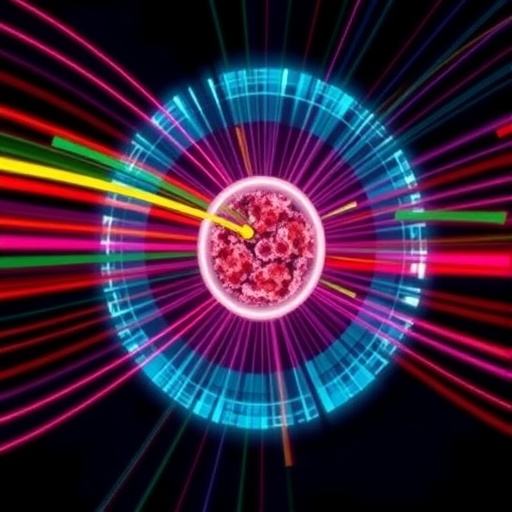In a groundbreaking advancement in the field of food microbiology and fermentation science, researchers from China have unveiled compelling evidence that magnetic fields (MFs) can be strategically harnessed to enhance the production of valuable secondary metabolites while simultaneously suppressing harmful compounds during microbial fermentation processes. The study, recently published in the esteemed journal Food Physics, focuses on the filamentous fungus Monascus purpureus, a microorganism renowned for its ability to produce Monascus pigments (MPs) — natural compounds widely utilized as food colorants and health supplements — alongside citrinin, a nephrotoxic mycotoxin presenting a significant safety concern.
Monascus species have long been celebrated in Eastern traditional food cultures, particularly for their role in generating red yeast rice, a fermented product credited with numerous health benefits including cholesterol reduction and blood pressure regulation. The production of monacolin K and gamma-aminobutyric acid (GABA) alongside Monascus pigments adds multifaceted nutritional and therapeutic value. However, the co-synthesis of citrinin by M. purpureus complicates the industrial and commercial viability of these fermented products, necessitating innovative approaches to selectively amplify beneficial metabolite output while minimizing toxin accumulation.
The research team embarked on an experimental journey to elucidate the influence of externally applied magnetic fields on the biosynthetic pathways of M. purpureus, particularly focusing on iron metabolism’s regulatory role in pigment and citrinin synthesis. Iron homeostasis within fungal cells is critical, as iron ions act as cofactors in various enzymatic reactions, and their intracellular concentration directly affects secondary metabolite pathways. Disrupting or fine-tuning iron availability, therefore, presents a promising avenue to manipulate fungal metabolism.
Leveraging controlled magnetic field intensities alongside the amino acid derivative L-allylglycine (L-AG), recognized as a suicide inhibitor that interferes with iron uptake and metabolism, the scientists designed an innovative combinatorial methodology. This approach aimed to alleviate intracellular iron overload, promote iron efflux mechanisms, and ultimately modulate the metabolic flux toward increased Monascus pigment production while mitigating citrinin synthesis.
The results of this study demonstrated that moderate magnetic field exposure could indeed enhance Monascus pigment biosynthesis without impeding the overall growth rate of M. purpureus. Remarkably, the combination treatment with L-AG allowed the microorganisms to maintain balanced intracellular iron levels through enhanced excretion pathways, which counteracted the negative inhibitory effects that L-AG alone imposed on pigment and citrinin production. This synergy reflects a complex regulatory mechanism by which magnetic fields and biochemical inhibitors can be orchestrated to optimize metabolite yields.
At the molecular level, magnetic fields appear to influence the expression and activity of iron transporters and storage proteins, adjusting the cellular iron reservoir in a manner conducive to favorable secondary metabolite synthesis. By reducing intracellular iron accumulation, the fungus minimizes the oxidative stress that otherwise could inhibit pigment production and promote citrinin biosynthesis via stress-induced pathways. The strategic attenuation of intracellular iron effectively shifts metabolic priorities towards safer and economically advantageous products.
This revelation holds profound implications for the food fermentation industry, especially sectors engaged in the mass production of natural pigments and nutraceuticals using Monascus species. Current safety concerns surrounding citrinin contamination have limited broader application and wider acceptance of red yeast rice products. The employment of magnetic fields as a non-invasive, cost-effective, and environmentally friendly physical stimulus opens avenues for scale-up and industrial integration without resorting to genetic modification or chemical additives that might raise regulatory or consumer apprehension.
Moreover, this research underscores a novel interdisciplinary convergence of microbiology, physics, and food technology, highlighting how external physical stimuli like magnetic fields can serve as precise tools to fine-tune microbial metabolism. Such approaches could be extended to other food-grade microorganisms, enhancing beneficial metabolite production across a multitude of fermentation-based processes, including those in pharmaceuticals, biofuels, and specialty chemicals.
From a practical perspective, the application of magnetic fields in fermentation reactors could be engineered to deliver controlled intensities and exposure durations, tailored to specific microbial strains and production goals. This control, combined with biochemical inhibitors like L-allylglycine, enables a multipronged strategy to optimize complex biosynthetic pathways. Additionally, understanding the underlying molecular and iron-related mechanisms offers opportunities for further refinement and customization of fermentation protocols.
The use of magnetic fields in biotechnology remains a relatively unexplored frontier with enormous potential. This study evidences not only the feasibility but also the efficacy of such physical modalities in enhancing microbial product safety and yield. The principles uncovered here may prompt a paradigm shift in how fermentation processes are designed and managed, emphasizing integrative controls beyond traditional nutritional and environmental parameters.
Looking ahead, the scientific community is encouraged to delve deeper into the mechanistic foundations of magnetic field interactions at the cellular and molecular levels. Comprehensive transcriptomic and proteomic analyses could illuminate the regulatory networks influenced by magnetic exposure, yielding new molecular targets for intervention. Similarly, explorations into the scalability and economic impact of MF-assisted fermentation could accelerate industrial adoption.
Corresponding author Mengxiang Gao expresses aspirations that these findings will spark a wave of research into exploiting magnetic fields to elevate the quality, safety, and efficiency of microbial secondary metabolite production. Beyond food science, such innovations hold promise for broad biotechnological applications, transforming microbial cell factories into more versatile and controllable bio-production platforms.
This transformative integration of physics with microbiological engineering exemplifies the exciting frontiers of modern fermentation science. By harnessing subtle but powerful forces like magnetic fields, researchers are rewiring ancient traditional processes to meet contemporary demands for sustainability, safety, and functionality in food ingredient production. As science advances, the invisible magnetic forces could become indispensable allies in the art and science of fermentation.
Subject of Research: Not applicable
Article Title: Effect of a magnetic field on the production of Monascus pigments and citrinin via regulation of intracellular and extracellular iron content
Web References: http://dx.doi.org/10.1016/j.foodp.2025.100070
Image Credits: Yang Yang, et al
Keywords: Food science, Microbiology, Molecular biology, Biomechanics




